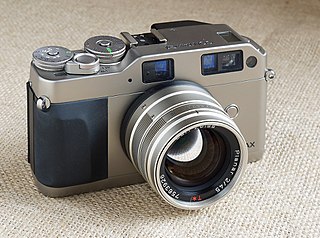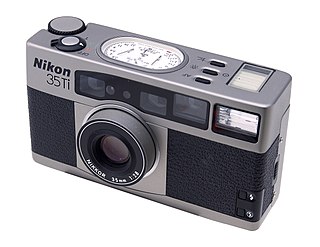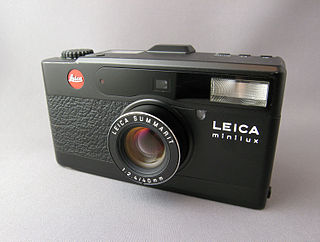
Rollei was a German manufacturer of optical instruments founded in 1920 by Paul Franke and Reinhold Heidecke in Braunschweig, Lower Saxony, and maker of the Rolleiflex and Rolleicord series of cameras. Later products included specialty and nostalgic type films for the photo hobbyist market.

TC-1 is a luxury point and shoot camera that was produced by Minolta. It is a compact 35 mm clad in titanium, equipped with a G-Rokkor 28mm f/3.5 lens. The TC-1 was equipped with a high quality lens and body, similar to other luxury compacts produced during the Japanese bubble economy era, including the Contax T line, Konica Hexar, Leica minilux, Nikon 28/35Ti, Ricoh GR series, and Rollei QZ 35W/35T. Expensive when initially released in 1996 with a suggested retail price of ¥148,000, it was produced in small numbers and since then has become collectible.

The Canon EOS 5 is a semi-professional autofocus, autoexposure 35 mm SLR film camera. It was sold from November 1992 onwards, and was replaced in late 1998 by the Canon EOS 3. As part of the EOS line of cameras, the 5/A2/A2e utilized Canon's EF bayonet lens mount, first introduced in 1987.

The Canon EF is a manual focus 35mm single-lens reflex camera produced by Canon between 1973 and 1978. It was compatible with Canon's FD-mount lenses. The EF was built as an electro-mechanical version of Canon's top-of-the line wholly mechanical Canon F-1. The shutter is mechanical at all speeds ½ second and faster, but at 1 second and longer the shutter is all electronically controlled, allowing AE exposures from 1/1000 to 30 seconds. The EF shares the F-1's rugged construction and tough metal body. Unlike the F-1, the EF does not support any motor drive for film transport. Neither does it provide any interchangeable viewfinder.

The Rolleiflex SL35 is a range of SLR cameras manufactured and sold by the German camera maker Rollei from 1970 to 1982. This range of cameras uses 35mm film. The camera bodies were initially made in Germany. After Zeiss Ikon discontinued camera production, Rollei acquired the Voigtländer brand and camera designs in 1972, and began producing a second generation of SLR cameras in Singapore starting from 1976. Some of those second-generation cameras were rebranded and marketed as Voigtländer VSL.

The history of the single-lens reflex camera (SLR) begins with the use of a reflex mirror in a camera obscura described in 1676, but it took a long time for the design to succeed for photographic cameras. The first patent was granted in 1861, and the first cameras were produced in 1884, but while elegantly simple in concept, they were very complex in practice. One by one these complexities were overcome as optical and mechanical technology advanced, and in the 1960s the SLR camera became the preferred design for many high-end camera formats.

The Minolta XG-M was a 35mm single-lens reflex camera introduced in 1981 by Minolta of Japan. It was also known as the X-70 on the Japanese market, in which it was not available until 1982. When released, it was the top model in Minolta's XG series of consumer-grade manual focus SLRs, replacing the XG-9. Changes from that model included a metered manual mode, and a revised body style with rearranged controls. This was also the first camera to use Minolta's new logo, which was used until the 2003 merger into Konica Minolta.

The Pentax ME F was an amateur level, interchangeable lens, 35 mm film, single-lens reflex (SLR) camera. It was manufactured by Asahi Optical Co., Ltd. of Japan from November 1981 to 1984. The ME F was a heavily modified version of the Pentax ME-Super, and a member of the Pentax M-series family of SLRs. It was the first mass-produced SLR camera to come with an autofocus system.

The Contax G camera line consists of two cameras, the G1 and G2, interchangeable-lens cameras sold by Kyocera under the Contax brand in competition with the Leica M7, Cosina Voigtländer Bessa-R, and Konica Hexar RF. The G1 was introduced in 1994 with the G2 joining it in 1996. In 2005, Kyocera retreated from the camera business and announced it would cease all activity related to the manufacture of Contax cameras at the end of the year, effectively spelling the end of the G system.

The Konica Hexar RF is a 35 mm rangefinder camera which was sold by Konica. It was introduced to the market on 13 October 1999. and subsequently discontinued some time before the end of 2003. The camera used the "Bayonet Konica KM-mount", a copy of the Leica M-mount, thus sharing interchangeable lenses with those designed for Leica cameras and others compatible with them. The Hexar RF has a combined rangefinder/viewfinder modeled on that of Leica cameras, a similar body shape and size - and so is similar to Leica M-mount cameras in many aspects of operation.

The Konica Hexar is a 35 mm fixed-lens, fixed focal length autofocus camera which was produced through the 1990s. It was introduced to the market in 1993. While styled like a rangefinder camera, and intended for a similar style of photography, in specification it is more like a larger "point and shoot" camera.

The Bessa family of cameras was manufactured in Japan by Cosina as a revival of the Voigtländer brand name between 1999 and 2015.

The Canon EOS 100 is a 35 mm autofocus SLR camera introduced by Canon in 1991. It was marketed as the EOS Elan in North America. It was the second camera in the EOS range to be targeted at advanced amateur photographers, replacing the EOS 650.

The Kodak Retina Reflex is a discontinued series of four single-lens reflex cameras made by Kodak in Germany between 1957 and 1974, as part of the Kodak Retina line of 35mm film cameras.

The Bessamatic and Ultramatic were lines of 35mm SLR cameras made by Voigtländer in the 1960s, featuring a selenium meter. It uses a leaf shutter, similar to competing SLR cameras manufactured by Kodak and Zeiss Ikon in Germany, rather than the focal plane shutter almost universally adopted by Japanese SLRs such as the contemporary Nikon F and Pentax Spotmatic. The Ultramatic was released in 1963, which used the same lens mount and added a shutter-priority autoexposure mode.

The Minolta X-1 was the professional model in the Minolta SR-mount line of single-lens reflex cameras (SLR), released in 1972 after ten years of development, which was the first X-series camera in the Minolta SLR system; prior to the X-1, specific Minolta SLR models were branded SR-T, and afterward, they included X in the name. The X-1 was the first SLR to combine an electronically-controlled shutter with interchangeable viewfinders.

Contarex is a line of 35mm single lens reflex cameras (SLRs) made by Zeiss Ikon. It was first presented at Photokina in 1958 and initially scheduled for delivery in the spring of 1959, but it was not made generally available in the United States until March 1960. The first model is popularly known as the Contarex I, the Bullseye, or the Cyclops, after the prominent light meter window above the lens, in front of the pentaprism. The camera was aimed at the high-end and professional markets; in 1961, the retail price was $499.

The Nikon 35Ti (1993) and Nikon 28Ti (1994) are luxury titanium-clad point and shoot cameras that were produced by Nikon, equipped with a high-quality lens and body, competing with similar luxury compact cameras produced during the Japanese bubble-economy era, including the Contax T line, Konica Hexar, Leica minilux, Minolta TC-1, Ricoh GR series, and Rollei QZ 35W/35T. Both the 35Ti and 28Ti are 35 mm cameras with nearly identical operation; as the name implies, the 35Ti is equipped with a 35 mm focal length lens, while the 28Ti is equipped with a 28 mm lens. Externally, they may be distinguished by their color: the 35Ti is finished in chrome/silver, and the 28Ti is finished in black.

The Leica minilux is the first in a series of four luxury titanium-clad point and shoot cameras that were produced by Leica Camera starting from 1995; it is equipped with a high-quality lens and body to compete with similar premium compact cameras produced during the Japanese bubble-economy era, including the Contax T line, Konica Hexar, Nikon 28Ti/35Ti, Minolta TC-1, Ricoh GR series, and Rollei QZ 35W/35T. All of the cameras in the minilux series, including the original minilux, Leica minilux zoom (1998), Leica CM (2004), and Leica CM ZOOM used 35 mm film; the minilux and CM were equipped with the same Leica Summarit lens, while the minilux zoom and CM Zoom were equipped with a Vario-Elmar lens.

The Vito and Vitomatic, Vitoret, and Vito Automatic were several related lines of 35 mm compact viewfinder and rangefinder cameras made by Voigtländer from the 1940s through the early 1970s, equipped with leaf shutters, similar in concept to and marketed against the competing Kodak Retina cameras manufactured by Kodak. All of these cameras were fixed-lens models; the models in the Vito line identified with Roman numerals were equipped with folding mechanisms and collapsible lenses for portability, while the others were rigid, non-folding cameras.




















